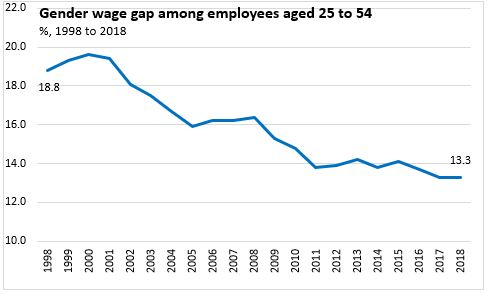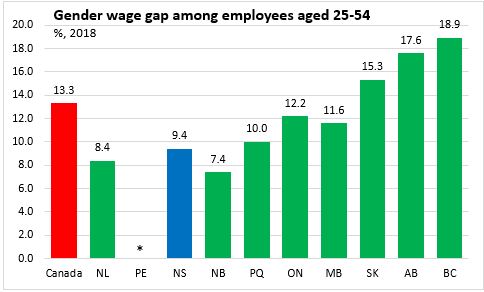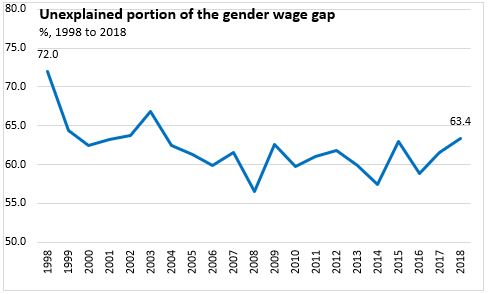The Economics and Statistics Division maintains archives of previous publications for accountability purposes, but makes no updates to keep these documents current with the latest data revisions from Statistics Canada. As a result, information in older documents may not be accurate. Please exercise caution when referring to older documents. For the latest information and historical data, please contact the individual listed to the right.
<--- Return to Archive
For additional information relating to this article, please contact:
October 07, 2019STUDY: THE GENDER WAGE GAP IN CANADA: 1998 TO 2018 Statistics Canada released a study today the describes the narrowing of the gender wage gap over the last twenty years and the factors that influenced this change. The study uses annualized data from the Labour Force Survey and aims to address three questions:
1. How did the gender wage gap in 2018 compare with the gap in 1998?
2. What factors contributed to the narrowing of the gender wage gap between 1998 and 2018?
3. What factors explain the gender wage gap in 2018, and did these factors differ from those that explained the gap in 1998?
In 1998, women aged 25-54 earned an average real hourly wage (adjusted for inflation) that was $5.17 less than the average real wage for men. This amounted to a gap of 18.8 per cent. From 1998 to 2018, real hourly wages grew faster for women (20.5 per cent) than for men (12.9 per cent). By 2018, the gap in real hourly wages declined to $4.13, or 13.3 per cent, reflecting a 5.5 percentage point decline in the gap.
The study notes that this decrease occurred in a step-wise manner over the period, with sharper declines during the early 2000s and around the 2008/2009 recession. Declines in the gap during these periods reflect stagnant or declining wages for men, instead of being primarily due to increases in women’s wages.

Across provinces, the gender wage gap in 2018 was lowest in the Atlantic provinces and highest in Saskatchewan, Alberta and British Columbia. In Prince Edward Island, there was no statistically significant difference in hourly wages between men and women.

*No statistically significant difference
The authors of the study use a statistical method called the Blinder-Oaxaca decomposition to determine the factors that contributed to the gap narrowing over the study period. This method breaks down the change in the wage gap into two parts: one that can be explained by relative changes in the characteristics of men and women, and another which is unexplained by changes in these measured characteristics. The unexplained portion includes the effect of any unobservables (which may include the impact of gender-based wage discrimination) and other measurable differences not included in this study (including total work experience or field of study). Therefore, it is important to note that the unexplained portion is not solely the effect of discrimination but includes other factors likely to have an impact on the wage gap.
The individual characteristics included in this study are education level, current job tenure, part-time employment, public sector employment, occupation, industry, and demographics (age, province, number of children and marital status). These characteristics were able to explain a total of 56.6 per cent of the narrowing of the gender wage gap between 1998 and 2018. The largest contributor was occupation (26.3 per cent of the decline), as more core aged women were employed in higher-paying occupational groups (including law and social, community and government services, education, and business and finance) in 2018 compared to in 1998. In these occupations, the wages of women grew faster than those of men. The second most important determinant of the declining gap was women’s increased educational attainment relative to men’s (12.7 per cent of the decline), as workers with higher education tend to earn more on average. Other contributors to the declining wage gap were the decline in male job tenure relative to females, decreasing union coverage among men (reflecting declines in the manufacturing sector over the first half of the period), declining part-time employment among women, an increased proportion of women in the public sector, and an increase in the proportion of women working in large firms. Industry distribution served to widen the gap (-8.0 per cent), driven by employment increases in construction, which is a male-dominated sector with relatively high wages. After taking these characteristics into account, 43.4 per cent of the decrease in the gender wage gap was unexplained by these characteristics. This is consistent with earlier research on the narrowing of the gap over time in Canada.
The final question addresses whether factors (individual characteristics) that explained the gap in 1998 are the same as the factors that explain the gap in 2018. In 2018, the factors considered in this study explain 36.6 per cent of the gender wage gap compared to 28.0 per cent in 1998. Over half of the wage gap was due to unexplained factors in all years 1998-2018. In this study, the unexplained portion varies considerably from year to year, with a lack of a clear trend over time. The authors note that caution should be used in drawing conclusions about the trends in explained or unexplained portions based on analysis at the end points.

The largest portion of the gap that could be explained by measured characteristics was the industrial distribution of men and women in 1998 (16.5 per cent) and 2018 (39.7 per cent), with the same sectors driving the gap in both years. Part-time employment among women explained similar portions of the gap in 1998 (8.9 per cent) and 2018 (9.2 per cent) due to the higher likelihood of women working part-time. Public sector employment and union status each counteracted the gap in 2018, consistent with the increase in public sector employment for women and declining union membership among men between 1998 and 2018. Education had virtually no impact on the gap in 1998, but counteracted it in 2018 (-4.8 per cent) reflecting that more women had a university degree (bachelor’s or above) in 2018 than men. Job tenure explained 2.3 per cent of the gap in 1998, and had little impact in 2018.
Source: Statistics Canada
Daily release | Full report
<--- Return to Archive